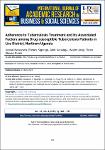| dc.contributor.author | Nabaziwa, Jannat | |
| dc.contributor.author | Kigongo, Eustes | |
| dc.contributor.author | Kabunga, Amir | |
| dc.contributor.author | Acup, Walter | |
| dc.contributor.author | Puleh, Sean Steven | |
| dc.date.accessioned | 2023-04-18T09:29:17Z | |
| dc.date.available | 2023-04-18T09:29:17Z | |
| dc.date.issued | 2023 | |
| dc.identifier.citation | Nabaziwa, J., Kigongo, E., Kabunga, A., Acup, W., & Puleh, S. S. (2023). Adherence to Tuberculosis Treatment and Its Associated Factors among Drug-susceptible Tuberculosis Patients in Lira District, Northern Uganda. International Journal of Academic Research in Business and Social Sciences, 13(4), 307 – 317 | en_US |
| dc.identifier.uri | DOI:10.6007/IJARBSS/v13-i4/16861 | |
| dc.identifier.uri | http://ir.lirauni.ac.ug/xmlui/handle/123456789/615 | |
| dc.description.abstract | Uganda has a high incidence of tuberculosis infection at 200 cases per 100,000 people. With
effective therapy and adherence to medications is essential for reducing the spread of
tuberculosis in the community. However, many of the initiated patients do not get to finish
the entire course of treatment. The purpose of this study was to investigate the level of and
factors associated with tuberculosis treatment adherence among drug-susceptible
tuberculosis patients in the Lira district. A facility-based cross-sectional survey was conducted
among 234 randomly selected tuberculosis patients between October and December 2022.
The Morisky medication adherence scale was used to measure adherence. Using a structured
questionnaire to collect data on socio-demographic characteristics, community factors, and
health service delivery factors associated with adherence. Binary logistic regression analysis
was used to determine the correlates of adherence to tuberculosis drugs at a p value of 0.05.
Most of the respondents (135, 57.7%) were males, (93, 39.7%) aged above 45 years, and (135,
57.7%) in a marital relationship. The prevalence of adherence to tuberculosis drugs was 84.6%
(198/234) and was associated with marital status (AOR: 0.307; 95% CI: 0.13-0.0724, p=0.007)
and the experience of stigma (AOR: 4.39; 95% CI: 1.612-11.958, p=0.004). The study reported
that 2 in 10 drug-susceptible tuberculosis patients are non-adherent, which is lower than the
targeted 90%. Marital status and stigma experience are predictors of non-adherence.
Interventions by the ministry of health should target how to improve tuberculosis treatment
and reduce stigma. | en_US |
| dc.language.iso | en | en_US |
| dc.publisher | International Journal of Academic Research in Business and Social Sciences | en_US |
| dc.subject | Adherence | en_US |
| dc.subject | Resistance | en_US |
| dc.subject | TB Patient | en_US |
| dc.subject | Tuberculosis | en_US |
| dc.title | Adherence to Tuberculosis Treatment and Its Associated Factors among Drug-susceptible Tuberculosis Patients in Lira District, Northern Uganda | en_US |
| dc.type | Article | en_US |

